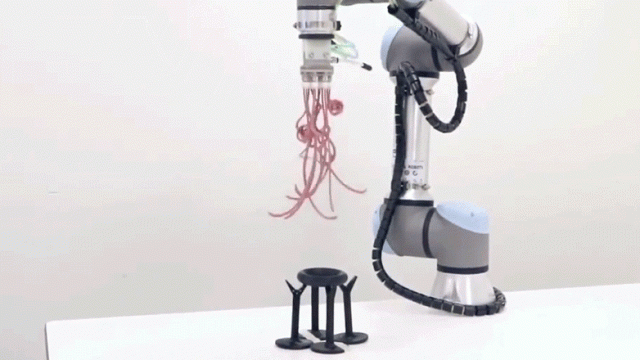Part of the versatility of the human hand’s ability to pick up almost anything comes from being able to apply a gentle touch for frail or oddly-shaped objects. That’s something robots struggle with, particularly when functioning autonomously, and unfortunately the solution could lie with an unorthodox gripper design that looks straight out of a horror movie.
It seems fitting that researchers from Harvard’s John A. Paulson School of Engineering and Applied Sciences should reveal their new gripper design so close to Halloween as it takes inspiration from bizarre sea creatures like octopi and jellyfish that rely on groups of long tentacles and filaments to ensnare and reel in prey for consumption. The giant squid has long been a mysterious creature of ocean lore, so why not recreate one in a lab setting?
Taking inspiration from animals to build robots designed to accomplish a specific task is far from a new idea. The human hand might be incredibly dextrous, but it’s also incredibly hard to replicate its abilities for a robot. Tentacles, on the other hand, are not, and it’s their simplicity that’s the key to how this gripper design works.

The artificial tentacles are made from foot-long hollow rubber tubes with one side being slightly thicker than the other. When empty, they become limp and seemingly lifeless, hanging like straight hair, but when pumped full of air, they become pressurised and curl up like a pigtail. The curling action is more or less completely random, so if you were to put an object next to one of the tentacles as it curled up under pressure, there’s a chance it might wrap around it, and a chance it won’t. But place an object next to a large group of these tentacles, and it’s all but guaranteed that at least a few of them are going to wind around the object as they curl, and each other, and the more of these entanglements that occur, the stronger the grip becomes.
Collectively the group of tentacles provides a strong hold on an object, but individually, each tentacle has a relatively weak grip meaning there’s little risk of a fragile object being damaged in the process. And because the tentacles only provide a secure hold when they’re pumped full of air, simply releasing that pressure will also release what’s being held.
Tested using both real-world experiments with the prototype as well as simulations, the researchers believe the new gripper design could be an effective alternative to what’s used today for handling everything from plants, to fruits and vegetables, to even delicate glassware. However, the design still comes with some issues that will need to be addressed before something like this shows up in factories or warehouses. The random nature of the entanglements means that objects that have been picked up can’t be put back down with the same amount of precision and accuracy as the vacuum grippers that are used to handle delicate objects today, which poses a big challenge for automated tasks like packaging, or prepping a part for the next stage in an automated assembly line.
